Is it possible to eat onions with diabetes
For people with diabetes, choosing the right food is important. Among the common questions that diabetics ask doctors is the following - is it possible to eat onions with sugar diabetes? It is a common vegetable culture that is used in salads, canned food, vegetable and meat dishes, soups, borscht, side dishes, and sauces.
Regardless of the severity of the disease, eating onions within the normal range will not harm health: on the contrary, it can have a beneficial effect on the course of diabetes mellitus, and serve as a prevention of complications. However, there are some contraindications and limitations.
The content of the article
Chemical composition, trace elements and characteristics of onions
There are several types and many varieties, hybrids and varieties of onions, differing in shape, size, color, taste, as well as medicinal and dietary properties. White, yellow, red onions and shallots are popular in Russia. Let's talk about the chemical composition and the effect on blood sugar levels using the example of yellow onions.
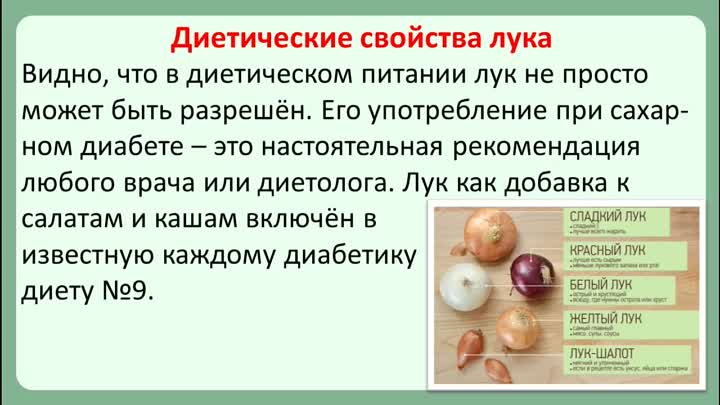
Nutrient content per 100 g of edible part:
| Alimentary fiber | 1.7 g |
| Water | 89.11 g |
| Ash | 0.35 g |
| Vitamins | |
| Beta carotene | 0.001 mg |
| Lutein + Zeaxanthin | 4 μg |
| Vitamin B1 | 0.046 mg |
| Vitamin B2 | 0.027 mg |
| Vitamin B4 | 6.1 mg |
| Vitamin B5 | 0.123 mg |
| Vitamin B6 | 0.12 mg |
| Vitamin B9 | 19 μg |
| Vitamin C | 7.4 mg |
| Vitamin E | 0.02 mg |
| Vitamin K | 0.4 μg |
| Vitamin PP | 0.116 mg |
| Betaine | 0.1 mg |
| Macronutrients | |
| Potassium | 146 mg |
| Calcium | 23 mg |
| Magnesium | 10 mg |
| Sodium | 4 mg |
| Sulfur | 11 mg |
| Phosphorus | 29 mg |
| Trace elements | |
| Iron | 0.21 mg |
| Manganese | 0.129 mg |
| Copper | 39 μg |
| Selenium | 0.5 μg |
| Fluorine | 1.1 mcg |
| Zinc | 0.17 mg |
| Digestible carbohydrates | |
| Mono- and disaccharides (sugars) | 4.24 g |
| Glucose (dextrose) | 1.97 g |
| Sucrose | 0.99 g |
| Fructose | 1.29 g |
| Essential amino acids | 0.279 g |
| Essential amino acids | 0.446 g |
| Sterols (sterols) | 15 mg |
| Saturated fatty acids | 0.084 g |
| Monounsaturated fatty acids | 0.013 g |
| Polyunsaturated fatty acids | 0.034 g |
Calorie content, BJU, nutritional value, onion glycemic index
Nutritional value of onions (per 100 g):
| Boiled without salt | Raw onions | |
| Calorie content | 44 kcal | 40 kcal |
| Protein | 1.4 g | 1.1 g |
| Fats | 0.2 g | 0.1 g |
| Carbohydrates | 8.8 g | 7.64 g |
The glycemic index (GI) of onions is 15 units. Heat treatment increases the GI if it was initially low. GI depends on the growing and storage conditions, the type of bulbs, the combination with other products, the method of heat treatment, the speed of enzymatic processes in the intestine.
For reference. The glycemic index of foods gives an idea of how fast carbohydrates will be broken down into sugar and released into the bloodstream. High-GI foods dramatically increase blood glucose levels and increase insulin production. Therefore, the basis of the diet of patients with sugar diabetes should be composed of foods with a low and medium glycemic index.
Does blood sugar increase or decrease
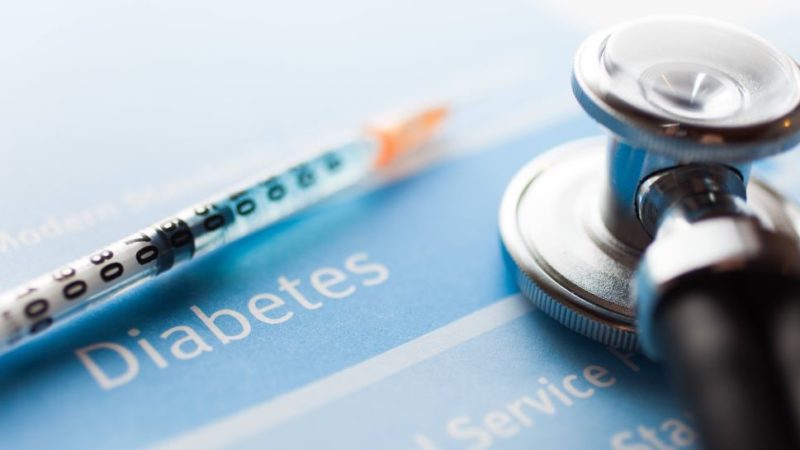
Is there sugar in onions? Bulbs contain carbohydrates in an amount of 7.6-8.8 g (depending on the variety, growing conditions and storage), of which 4.24 g is mono- and disacchara, 1.97 g is glucose, 0.99 g is sucrose , 1.29 g - fructose. Mono- and disaccharides are an irreplaceable source of energy, there is no need to break them down additionally, and the content of other types of sugars is insignificant and cannot significantly increase the glucose level.
Conversely, onions lower blood sugar in humans.The carbohydrates present in the composition are digested and absorbed gradually, respectively, for a long time they maintain the glucose level at the same level, without causing hunger. In addition, the composition contains a lot of fiber, which slows down the absorption of carbohydrates, stimulates the intestines, normalizes the metabolism, which is important for sugar diabetes.
What vitamins and beneficial properties are present in onions
Nature has enriched the bulbs with substances valuable for the human body:
- beta-carotene - a powerful antioxidant that prevents free radicals from damaging cells, takes part in the formation of new cells;
- B vitamins - are responsible for the proper functioning of the enzymatic systems of carbohydrate, lipid and protein metabolism, are involved in oxygen transport, regeneration processes, normalize the functioning of the nervous, endocrine, cardiovascular systems;
- vitamin E - lowers blood glucose levels, improves blood circulation, supports metabolism in the liver, nervous system, heart muscle, prevents premature aging;
- vitamin C - supports oxidative reactions in the body, increases the density and elasticity of the vascular walls, provides a good body resistance to infections;
- vitamin K - takes part in the mineralization of teeth and the formation of bone tissue, prevents the development of prostate cancer;
- vitamin PP - has an anti-allergic effect, improves the activity of blood vessels, normalizes the lipid composition of the blood, lowers the level of bad cholesterol.
Onions have a wide range of beneficial effects. It is used as an anti-inflammatory, analgesic, wound-healing, antimicrobial, diuretic, antipyretic agent.
The bulbs contain insoluble dietary fibers that have a beneficial effect on the state and functions of the digestive system - they activate metabolism, accelerate the breakdown of fats, prevent the formation of new fatty deposits, cleanse the intestines of toxins and toxins, and have a mild laxative effect.
Can I eat onions for type 1 and type 2 diabetes?

Ideally, it is advisable to include onions in almost every meal - it stabilizes the level of glucose in the blood, respectively, reduces the load on the pancreas. They can use it in any form - fresh, baked, boiled, steamed, stewed.
How can he harm
Prolonged and abundant consumption of raw and fried onions can harm the body.
It is recommended to completely eliminate fried onions. from the diet of diabetics or to minimize. Due to the excess fat content, it has a high calorie content (258 kcal), saturated with fats (14 g per 100 g), and the glycemic index tends to 100 units.
This means that after eating fried onions, blood sugar rises sharply, and the release of insulin by the pancreas increases. The production of large amounts of insulin lowers the glucose level, after a while the feeling of hunger reappears, followed by another meal. And instead of losing weight, there is an excessive accumulation of adipose tissue in the body, which is extremely undesirable for diabetics.
Raw onions are limited in the diet of diabetics 1 and 2 types, if there are concomitant diseases from the digestive system. The composition contains aggressive essential oils, organic acids, which provoke mechanical, chemical irritation of the mucous membranes, which is manifested by abdominal pain, nausea, vomiting, heartburn, and a deterioration in general well-being.
What can be useful
The obvious benefit of onions for people with diabetes is their low glycemic index. This means that the conversion of carbohydrates to glucose, absorption and an increase in blood sugar levels after eating onions occurs gradually.Maintaining glucose within the normal range prevents the development of acute conditions, serves as a prevention of complications of diabetes mellitus.
For reference... Onions take longer to digest raw, which ensures long-term satiety, prevents the formation of new fat deposits and helps control weight.
The vegetable fiber present in the bulbs slows down the absorption of sugar from complex carbohydrates, improves digestion, absorbs toxic substances from the intestines and removes them outside, and normalizes metabolism.
Onions for diabetics are a source of iodine. Its deficiency slows down the synthesis of thyroid hormones, which leads to metabolic disorders, a decrease in insulin production.
Onions are rich in allicin. This organic substance has a pronounced bactericidal effect, and its benefit for diabetics is to increase the absorption of glucose, to bring the blood composition back to normal. Onions to some extent satisfy the needs for sulfur and nickel, which are involved in the metabolism, ensure the normal functioning of the pancreas.
How and how often to eat onions for type 1 and 2 diabetes
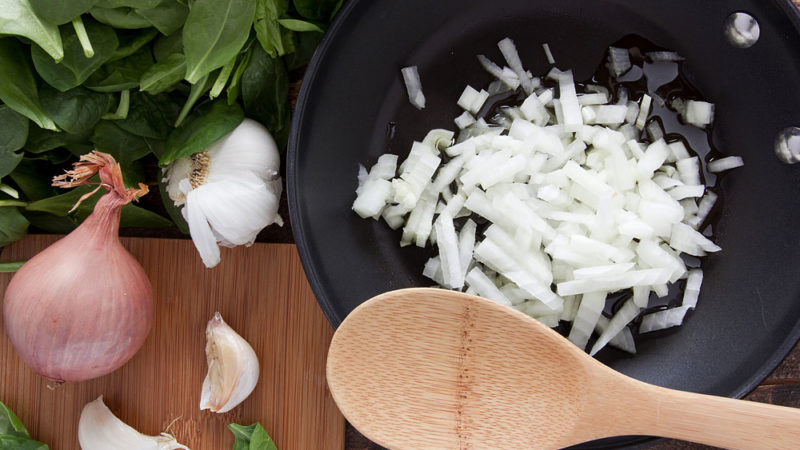
For patients with type 1 and type 2 diabetes, onions and green onions are included in the list of permitted products. The main condition is the even distribution of carbohydrates and accounting for the amount eaten. Bulbs are consumed raw or pre-stewed, baked, boiled, steamed, sauteed. A vegetable should be present in the diet daily, but in limited quantities - 1-2 medium-sized onions.
Baked onions are used as medicinal raw materials. For 2-3 weeks, every morning on an empty stomach, eat ¼ of an onion baked in the oven or in a dry frying pan.
Leek is no less useful for diabetics. Its chemical composition is not inferior to onion, but it has a more delicate and even sweetish taste.
How to choose fresh onions
The quality and properties of onions are influenced by the growing and storage conditions. Ideally, they consume onions of their own harvest or grown in guaranteed safe conditions without adding pesticides.
When buying a vegetable in the market, in a supermarket or store, they pay attention to the appearance, size, smell:
- yellow onions of proper quality have a glossy golden peel without traces of spoilage, damage by agricultural pests, mold;
- the bulbs are dense and elastic to the touch, without the foreign smell of mustiness, sweetness;
- in the upper part of the bulbs there is a dry plait of scales, the lower part is dry, without roots;
- medium-sized bulbs (4-5 cm), but heavy - too large onion heads contain excessive moisture, which can impair the taste and reduce the beneficial properties of the vegetable.
How to store
Onions are stored in the refrigerator for about a month or throughout the winter in a damp, cool room. In the refrigerator, onions are stored in a sealed plastic container separately from other vegetables and fruits.
For long-term storage, the bulbs are dried in the fresh air, the external dry scales are removed, the root processes are cut off, and the spoiled specimens are removed. The bulbs are put in wicker baskets, dry wooden boxes, fabric bags, special nets for storing vegetables.
Important. In the room where the onion will be located, constant conditions must be maintained: darkening, fresh and clean air, temperature - 0 ... + 5 ° С, humidity - 80-90%.
In what form to use
The most suitable heat treatment methods for diabetics are steaming and baking. In this form, the vegetable practically does not lose substances valuable for the body, the calorie content and glycemic index remain practically unchanged, which is especially important for overweight people.
With what
Onions go well with almost all foods. Bulbs and leaves are used in salads, vinaigrettes, canned food, meat and vegetable dishes, as an additive to first and second courses, gravies, minced meat, processed into juice.It well complements sausages, cottage cheese, cheeses, bacon, porridge, potatoes and dishes made from it.
Onion recipes for type 1 and type 2 diabetes
Onions are harvested within several months, they are inexpensive, do not require special storage conditions, therefore they have become an integral part of the first and second courses, side dishes.
Culinary experts and nutritionists have come up with many recipes for preparing tasty and healthy onion dishes.
Onion soup with celery
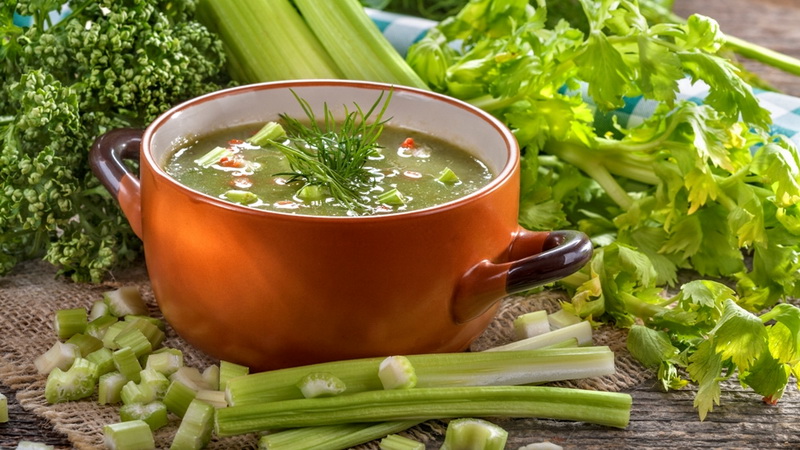
Products:
- white onions - 3 pcs.;
- ripe tomatoes - 3 pcs.;
- sweet bell pepper - 1 pc .;
- carrots - 3 pcs.;
- celery root - 200 g;
- salt to taste;
- parsley, dill - to taste.
Recipe.
- Peel the onion, cut into half rings.
- Grate the carrots.
- Peel the bell pepper from seeds, cut into strips.
- Bake celery root in the oven, chop medium-sized.
- Pour boiling water over the tomatoes, remove the peel, cut into 4 parts (if large, into 6-8 parts).
- Put all the vegetables in boiling water. Boil over low heat until soft. 5 minutes before being ready, salt to taste. Garnish with finely chopped herbs before serving.
Cottage cheese with green onions
Ingredients:
- low-fat cottage cheese - 200 g;
- green onion feathers - 50 g;
- parsley, dill - to taste;
- salt, spices to taste.
Recipe:
- Rinse the herbs, remove the remaining water with a paper towel. Chop finely.
- Mix cottage cheese with herbs, salt, add spices to taste (for example, paprika, black pepper). Mix.
Diet Onion Pie
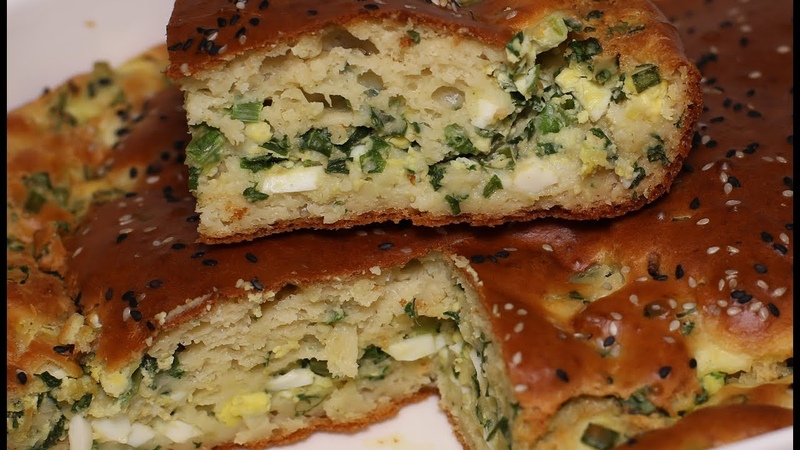
Ingredients:
- onions - 3-4 heads;
- wheat flour - 250 g;
- chicken eggs - 1 pc .;
- low-fat unsweetened yogurt - 300 g;
- water - 3 tsp;
- salt on the tip of a knife;
- sugar - ½ tsp;
- low-fat cheese (for example, mozzarella) - 100 g;
- vegetable broth - 3 tbsp. l .;
- vegetable oil - 120 ml and for greasing the mold.
How to make an onion pie:
- Sift flour, add salt, olive oil. Knead the elastic dough.
- Leave the dough to rest under cling film for 30 minutes.
- Roll out the dough 2 cm thick, put in a greased mold. Put dry peas on the bottom. Put in a preheated oven for 15 minutes at a temperature of 180-200 ° C.
- Cut the onion into small pieces, sauté in a little water. After 15 minutes, add salt, sugar, pour in vegetable broth. Simmer over low heat for 10-15 minutes without a lid.
- Remove the peas from the dough, put the cooled onion, pour on top with a mixture of yogurt and eggs. Sprinkle with hard cheese. Bake in an oven preheated to 180 ° C for about 25-30 minutes.
Healing recipes
Onion peel and onion itself are used as medicinal raw materials. As a remedy for the treatment of diabetes and other diseases (for example, ischemia, arterial hypertension, for the prevention of heart failure), onion tincture in water has proven itself well.
The tool has a versatile effect: it regulates glucose levels, improves digestion, and produces a slight diuretic effect.
How to prepare the infusion:
- Peel three medium-sized onion heads, chop medium-sized.
- Pour 400 ml of the onion with boiled warm water.
- Insist covered at room temperature for about 8 hours, you can leave it overnight.
- The filtered infusion is taken orally before meals, 100 ml three times a day. The course of treatment is 20 days.
Prevents the development of acute conditions and serves as the prevention of complications in diabetes mellitus decoction of onion peel:
- 1 tbsp. l. Pour 100 ml of boiling water over chopped onion husks. Heat in a water bath and cook for 10-15 minutes from the moment of boiling.
- Let it brew under the lid for 2-3 hours, strain through several layers of gauze.
- Take 50 ml in the morning and evening half an hour before meals.
Sometimes onions are combined with other products that enhance its medicinal properties and complement them with new effects. Nutritionists recommend taking a vegetable mix on an empty stomach for a month. To do this, prepare freshly squeezed onion, potato and cabbage juices, mix in equal proportions of 50 ml.
For reference... Mix of vegetable juices is contraindicated in the presence of problems with the gastrointestinal tract.
Conclusion
Onions for diabetes are included in the list of permitted foods and should be present in the daily menu. It regulates blood sugar levels, normalizes metabolism, and supports the health and function of the thyroid gland.
Fried onions are contraindicated for diabetics. The best cooking methods are baking, boiling, stewing with a little water. A wide range of actions allows the use of onions as medicinal raw materials in the form of infusion, decoction. Such treatment has contraindications, therefore, all actions are preliminarily agreed with the endocrinologist.